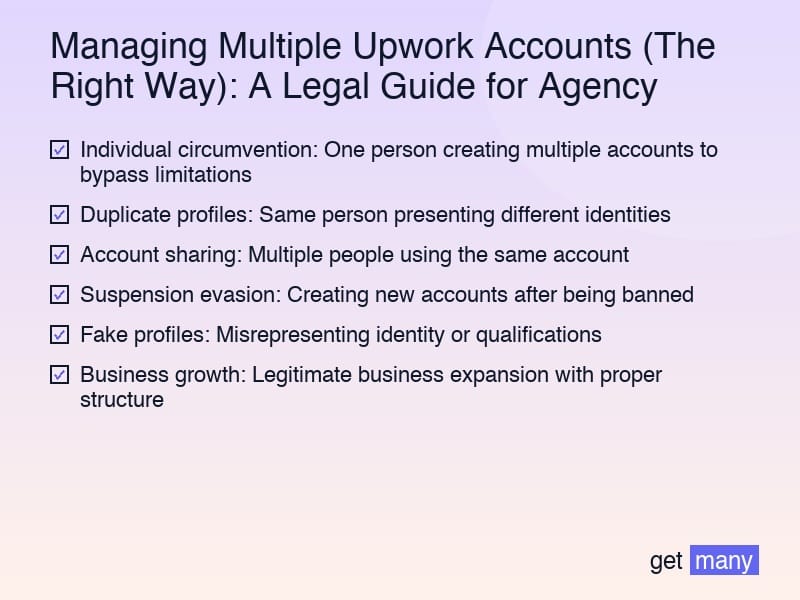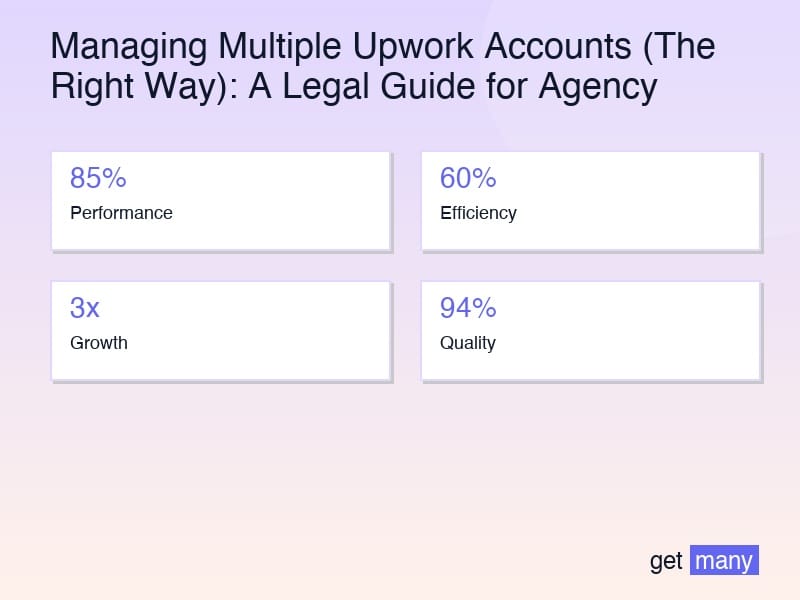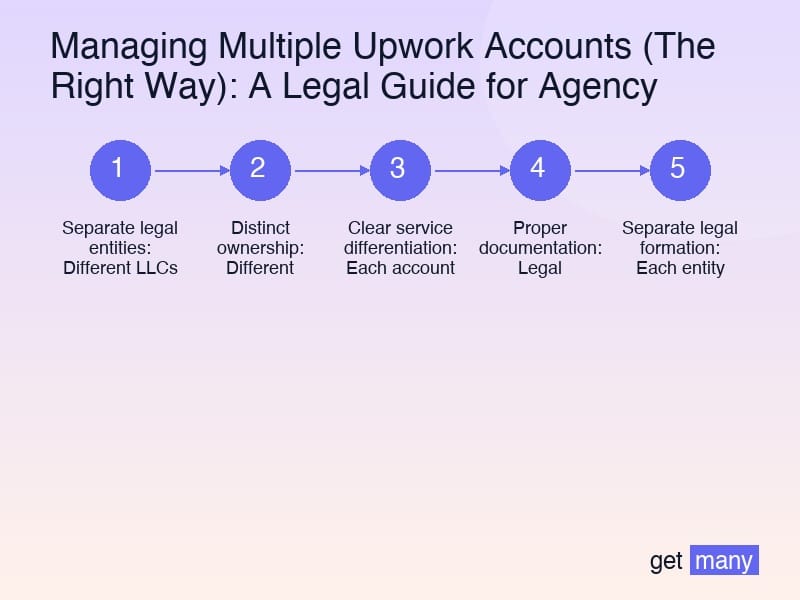Managing Multiple Upwork Accounts (The Right Way): A Legal Guide for Agency Owners
Navigate the complex world of multiple Upwork accounts legally and ethically. The definitive guide to scaling your agency without violating ToS.
The question comes up in every agency owner's mind: "Can I have multiple Upwork accounts to scale my business?" The answer is nuanced, and getting it wrong can destroy years of work. After consulting with legal experts and analyzing hundreds of agency structures, I'll show you the compliant ways to scale your presence on Upwork.
This isn't about gaming the system—it's about understanding the rules and building sustainable business structures that protect your growth and comply with Upwork's Terms of Service.
Understanding Upwork's Terms of Service

Before diving into strategies, let's clarify what Upwork actually permits and prohibits regarding multiple accounts.
What Upwork Explicitly Prohibits
- Individual circumvention: One person creating multiple accounts to bypass limitations
- Duplicate profiles: Same person presenting different identities
- Account sharing: Multiple people using the same account
- Suspension evasion: Creating new accounts after being banned
- Fake profiles: Misrepresenting identity or qualifications
What Upwork Permits
- Business growth: Legitimate business expansion with proper structure
- Team specialization: Different team members with distinct expertise
- Service diversification: Separate entities offering different services
- Geographic expansion: Different legal entities in different regions
- Succession planning: Transferring account ownership through proper channels
The Legal Framework for Multiple Accounts

The Individual vs. Business Account Distinction
Individual accounts are tied to specific persons and cannot be transferred or shared. Business accounts represent companies and can have multiple team members.
Key Legal Structures That Support Multiple Accounts
- Separate legal entities: Different LLCs or corporations
- Distinct ownership: Different individuals owning different accounts
- Clear service differentiation: Each account serving different market segments
- Proper documentation: Legal paperwork supporting the structure
Strategy 1: The Multi-Entity Approach

The Structure
Create separate legal entities for different service lines or markets:
Example structure:
- Main Agency LLC: General digital marketing services
- Design Studio LLC: Specialized design services
- Development Corp: Software development projects
- Content LLC: Content creation and copywriting
Implementation Requirements
- Separate legal formation: Each entity must be properly registered
- Distinct management: Different authorized representatives
- Clear service boundaries: No overlap in service offerings
- Separate financials: Independent bank accounts and accounting
- Unique branding: Different company names, logos, and positioning
Benefits
- Risk diversification: Issues with one entity don't affect others
- Specialized positioning: Each entity can focus on specific niches
- Scalability: Multiple revenue streams and growth opportunities
- Legal protection: Proper corporate structure provides liability protection
Considerations
- Higher complexity: More administrative overhead
- Increased costs: Multiple registrations, filings, and maintenance
- Management burden: Coordinating multiple entities
- Potential confusion: Client and team management complexity
Strategy 2: The Team Member Approach
The Structure
Legitimate team members create their own accounts under your guidance and coordination:
Requirements for team member accounts:
- Real individuals: Actual employees or contractors
- Separate identities: Each person uses their own credentials
- Independent work: Team members complete work under their own profiles
- Clear hierarchy: Proper employment or contractor relationships
- Transparent communication: Clients understand the team structure
Implementation Framework
- Hire qualified individuals: People with real skills and experience
- Create proper employment agreements: Clear roles and responsibilities
- Maintain separate profiles: Each team member builds their own reputation
- Coordinate behind the scenes: Project management and quality control
- Share opportunities: Distribute work based on skills and availability
Benefits
- Authentic representation: Real people with real skills
- Distributed risk: Multiple accounts mean multiple revenue streams
- Skill specialization: Each account can focus on specific expertise
- Scalable growth: Easy to add new team members
- Compliance safety: Fully compliant with Upwork's terms
Management Considerations
- Team coordination: Ensuring consistent quality and communication
- Revenue sharing: Fair compensation structures
- Brand consistency: Maintaining unified client experience
- Quality control: Monitoring and improving team performance
Strategy 3: The Succession Planning Approach
The Structure
Plan for account transfer and ownership succession:
Transfer scenarios:
- Business sale: Transferring accounts as part of business acquisition
- Partnership changes: Adding or removing business partners
- Succession planning: Transferring to next generation or key employees
- Geographic expansion: Creating regional subsidiaries
Legal Requirements
- Proper documentation: Legal agreements supporting transfers
- Upwork notification: Following proper transfer procedures
- Identity verification: Ensuring all parties are properly identified
- Financial transparency: Clear financial arrangements
- Compliance maintenance: Ongoing adherence to terms
Risk Management and Compliance
Common Violations to Avoid
- Account sharing: Never let multiple people use the same login
- Identity misrepresentation: Always use real names and information
- Circumvention attempts: Don't create accounts to bypass limitations
- Duplicate work: Don't bid on same projects from multiple accounts
- Artificial manipulation: Don't use multiple accounts to boost ratings
Monitoring and Maintenance
Regular compliance audits:
- Review account activity for potential violations
- Ensure proper documentation is maintained
- Monitor team member account usage
- Verify legal structures remain compliant
- Update procedures as Upwork's terms evolve
Documentation Requirements
Maintain records of:
- Legal entity formation documents
- Employment/contractor agreements
- Account ownership verification
- Financial separation records
- Communication logs with Upwork support
The Business Case for Multiple Accounts
Revenue Diversification
Multiple accounts allow you to:
- Access different market segments
- Reduce dependency on single accounts
- Experiment with different positioning
- Scale beyond individual account limitations
Risk Mitigation
Properly structured multiple accounts provide:
- Protection from account suspension
- Diversified revenue streams
- Reduced client concentration risk
- Flexibility in business operations
Market Expansion
Multiple accounts enable:
- Geographic market expansion
- Service line diversification
- Industry specialization
- Competitive positioning
Technology and Operations Management
Coordinating Multiple Accounts
Management tools:
- Separate browser profiles: Keep accounts isolated
- VPN considerations: Use consistent IP addresses
- Communication systems: Coordinate team activities
- Project management: Track work across accounts
Quality Control Across Accounts
Consistency measures:
- Standardized processes: Uniform quality standards
- Brand guidelines: Consistent communication style
- Training programs: Ensure all team members meet standards
- Regular reviews: Monitor performance across accounts
Client Management
Avoiding conflicts:
- Clear service boundaries: No overlap in service offerings
- Client communication: Transparency about business structure
- Referral systems: Proper handoffs between accounts
- Quality assurance: Consistent experience across accounts
The Getmany Advantage for Multiple Accounts
Managing multiple Upwork accounts requires sophisticated proposal management and lead tracking. Getmany provides:
Multi-account management:
- Centralized dashboard: Monitor all accounts from one location
- Automated proposal generation: Consistent quality across accounts
- Lead distribution: Optimize opportunities across team members
- Performance tracking: Monitor success rates across accounts
Compliance support:
- Activity monitoring: Track account usage patterns
- Documentation tools: Maintain compliance records
- Alert systems: Identify potential violations
- Reporting features: Generate compliance reports
Common Mistakes and How to Avoid Them
Mistake 1: Rushing the Setup Process
Problem: Creating accounts without proper legal structure Solution: Establish legal entities and documentation first
Mistake 2: Inadequate Separation
Problem: Too much overlap between accounts Solution: Maintain clear boundaries and distinct operations
Mistake 3: Poor Documentation
Problem: Insufficient records to prove compliance Solution: Maintain comprehensive documentation of all activities
Mistake 4: Team Member Confusion
Problem: Team members unclear about account usage rules Solution: Comprehensive training and clear guidelines
Mistake 5: Neglecting Ongoing Compliance
Problem: Failing to monitor and maintain compliance Solution: Regular audits and updates to procedures
Legal Considerations by Jurisdiction
United States
- LLC formation: State-specific requirements
- Tax implications: Multiple entity tax considerations
- Employment law: Contractor vs. employee classifications
- Business licensing: Professional licensing requirements
International Considerations
- Cross-border operations: International tax implications
- Local regulations: Country-specific business requirements
- Currency considerations: Multi-currency financial management
- Legal structure options: Different entity types available
Building Your Multiple Account Strategy
Step 1: Assessment and Planning
- Evaluate business goals: What do you want to achieve?
- Assess legal requirements: What structures are needed?
- Analyze resources: What are the costs and complexities?
- Plan implementation: What's the timeline and process?
Step 2: Legal Structure Creation
- Entity formation: Create necessary legal entities
- Documentation preparation: Develop required paperwork
- Financial setup: Establish separate banking and accounting
- Compliance systems: Implement monitoring and reporting
Step 3: Account Creation and Management
- Proper account setup: Follow Upwork's procedures
- Team training: Educate all account users
- Quality control: Implement management systems
- Ongoing monitoring: Regular compliance reviews
Step 4: Scaling and Optimization
- Performance analysis: Monitor success across accounts
- Optimization opportunities: Improve processes and results
- Expansion planning: Plan for future growth
- Risk management: Ongoing compliance and protection
Measuring Success Across Multiple Accounts
Key Performance Indicators
Account-level metrics:
- Revenue per account: Track individual account performance
- Win rates: Proposal success across accounts
- Client retention: Long-term relationship management
- Quality scores: Maintain high standards across accounts
Portfolio-level metrics:
- Total revenue growth: Overall business expansion
- Risk distribution: Revenue diversification across accounts
- Market penetration: Success in different segments
- Operational efficiency: Management overhead per account
Reporting and Analysis
Monthly reporting:
- Account performance summaries
- Compliance status updates
- Financial performance analysis
- Risk assessment reports
Future-Proofing Your Multiple Account Strategy
Staying Current with Policy Changes
- Regular terms review: Monitor Upwork policy updates
- Legal consultation: Periodic legal review
- Industry monitoring: Stay informed about best practices
- Adaptation planning: Prepare for potential changes
Scaling Considerations
- Growth planning: Anticipate future account needs
- Technology updates: Invest in management tools
- Team development: Build internal capabilities
- Market expansion: Identify new opportunities
The Bottom Line
Multiple Upwork accounts can be a powerful tool for scaling your agency, but only when implemented correctly within legal and ethical boundaries. The key is proper planning, legal structure, and ongoing compliance management.
The agencies that successfully use multiple accounts do so transparently, with proper legal structures, and with genuine business justification. They invest in proper setup, maintain clear boundaries, and prioritize compliance over shortcuts.
Remember: The goal isn't to circumvent Upwork's systems—it's to build a sustainable, scalable business that operates within the platform's guidelines while maximizing your growth potential.
Success with multiple accounts requires patience, planning, and professional execution. But when done right, it can provide the foundation for building a truly scalable agency that isn't limited by the constraints of a single account.
Ready to scale your agency presence on Upwork? Getmany can help you manage multiple accounts effectively while maintaining compliance and maximizing your proposal success across all platforms. Start building your compliant multi-account strategy today.





